Ballistic Study of Happy Firing in An Indian Marriage Ceremony
Manoj Kumar Pathak*, Mayank Gupta, Satish Kumar Khalkho, Shashank Shekhar Jha and Srishti Rai
Department of Forensic Medicine, Institute of Medical Sciences, Banaras Hindu University, India
Submission: June 22, 2018;Published: July 03, 2018
*Corresponding author: Manoj Kumar Pathak, Department of Forensic Medicine, Institute of Medical Sciences, Banaras Hindu University, Varanasi, India, Tel: 9450179177; Email: drmanojpathak@gmail.com
How to cite this article: Manoj Kumar Pathak, Mayank G, Satish K K, Shashank S J, Srishti R . Ballistic Study of Happy Firing in An Indian Marriage Ceremony. J Forensic Sci & Criminal Inves 2018; 9(4): 555770. DOI:10.19080/JFSCI.2018.09.555770.
Abstract
Introduction: A firearm is a thermodynamic machine in which the potential energy of the gun-powder is transformed into the kinetic energy of the projectile. Use of firearm is increasing worldwide and Varanasi is no exception to this.
Material and Method: Details and findings of this case were painstakingly explored at autopsy room of Institute of Medical Sciences, B.H.U., Varanasi. Victim’s personal history, supportive treatment and investigation records were collected.
Result: A 4-year-old male child of length 99 cm and weight 21 Kgs came to the mortuary Department of Forensic Medicine, IMS BHU, Varanasi on 31/05/2018 at 4.30 PM for medicolegal post-mortem examination. His eyes and mouth were closed. No bleeding from external orifices was present. Post-mortem lividity and rigor mortis was present all over the body.
Conclusion: The practice of celebratory firing by over-enthusiastic and unskilled persons or defective, faulty or old and ill maintained firearms may cause accidental death of the persons during celebratory firing and may change the happiness of the ceremony into highly tragic event.
keywords: Richochet; Slug; Buckshot; Recoil Velocity; Ballistics
Background

In a marriage ceremony under Chandwak Police Station in Bantari Village of Scheduled Caste community on 30/05/2018 in the afternoon, everything was fine. Marriage ceremony was going on smoothly. Suddenly the bride-groom party under excitement of marriage ceremony fired from the licensed single barrel12 bore shotgun. In this fire the cartridge struck the ceiling of the roof first and then after ricocheting get fragmented and pellets injured 9 persons who were present there and taking part in marriage ceremony. All nine injured persons were taken to hospital and were admitted. Out of those nine injured persons, one male child, 4 years old, succumbed to death due to firearm injuries at different body regions. Immediately police rushed to the incidence place and seized the weapon used during the firing. Passage of shotgun pellets through any target before they strike the body, cause the pellets to spread. Shotgun slugs usually produce large, gaping circular to oval defects with irregular margin. The internal injury is highly destructive and similar to that caused by buckshot resembles bullet wound (Figure 1).
Introduction
Firearm in any instrument or device designed to propel a projectile by means of explosion of gases generated by combustion of an explosive substance [1]. A firearm is a thermodynamic machine in which the potential energy of the gunpowder is transformed into the kinetic energy of the projectile [2]. Gunshot trauma is commonly encountered by the forensic medicine specialist. The ability to interpret gunshot wounds correctly is essential to arrive at the correct determination of the cause and manner of death [3].Use of firearm is increasing worldwide and Varanasi is no exception to this [4].Invention of fire was the greatest invention for the human civilization but the invention has proved to be a curse to this world (Figure 2). it has become the most dreaded killing tool used by human beings to kill them [4]. According to National Crime Statistics, 38.6% of victims of murder were in the age group of 18-30 years. In Uttar Pradesh also, this age group was predominant with 1476 male victims, 488 female victims and 1964 numbers of victims were transgender [5]. In year 2016, number of victims murdered by licensed were 181 and murdered by unlicensed firearms were 1302, hence total number of victims of firearms were 1483. National average was 322, 3453 and 3775respectively [5].
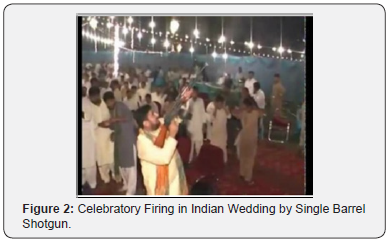
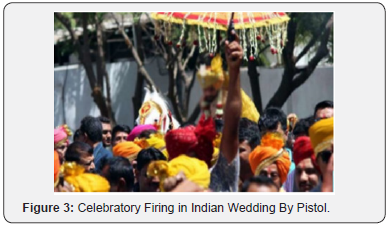
In year 2015, numbers of victims murdered by licensed firearms was 172 and by unlicensed firearms were 1445 and total numbers of murdered victims in U.P. were 1617. The all India total were 356, 3366 and 3722 respectively [5]. Though overall incidence of fatal firearm injury is reduced because of legal restriction on licence of personal firearm weapons, the incidence of firearm injury due to country made guns are increased which are illegal, easily available and cheap [4]. According to national statistics total 17429 numbers of firearms were seized in U.P. out of which 16990 were country made arms and 439 were licensed/factory made firearms (Figure 3). The nation average was 37116, 1052 and 36064 respectively [5]. The 12 bore shotgun is the most popular shotgun. It strikes a balance between the weight and effectiveness of the weapons. Most of the shotguns, therefore, had barrels over 90 centimetres [6]. A typical gunshot entrance wounds are created when the bullet is destabilized prior to entering the body and consequently does not enter the body nose first but sideways or at an angle (Figure 4). The most common cause is bullet ricochet. Ricochet bullet is a rebound, deviation or deflection of a bullet from its course by striking an intermediate surface. Sometimes the bullet may strike the surface but fail to penetrate and glance off. Such projectiles are commonly deformed, and deformity depends upon texture of the bullet, critical angle of impact and intermediary object [7] (Figure 5).
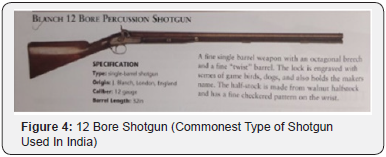

Material and Method
Details and findings of this case were painstakingly explored at autopsy room of Institute of Medical Sciences, B.H.U., Varanasi. Victim’s personal history, supportive treatment and investigation records were collected. These all facts were analysed thoroughly with existing literature support.
Result
A 4-year-old male child of length 99 cm and weight 21 Kgs came to the mortuary Department of Forensic Medicine, IMS BHU, Varanasi on 31/05/2018 at 4.30 PM for medicolegal post-mortem examination. His eyes and mouth were closed. No bleeding from external orifices was present. Post-mortem lividity and rigor mortis was present all over the body (Figures 6-9).

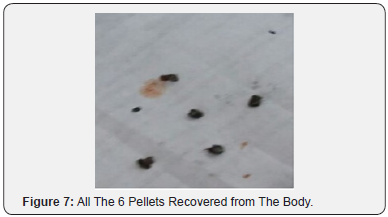
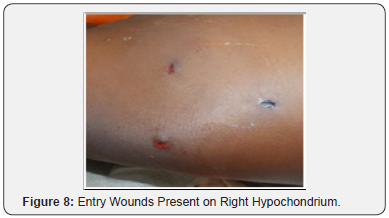
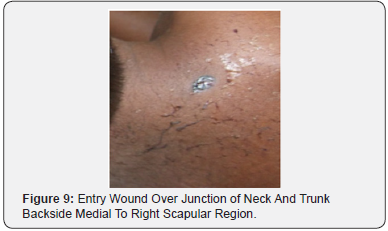
Ante-mortem Injuries
i. Entry wound 3mm on lower side of neck 3cm away from midline, was present and metallic pellet of 2gm weight was recovered from that site.
ii. Three entry wounds in area of lower part of thorax on right side over an area of 6cm X 7cm X 7cm were present. Three metallic pellets were recovered (one small 0.5 gm weight and two of big size weighing 1gm each). On further examination, one small tiny pellet was recovered from right side of the liver. Half of the liver was ruptured.
iii. Entry wound of 3-4mm size was present on the middle of the right leg. Further one metallic pellet was recovered from this site also.
iv. Entry wound of 3-4mm in diameter was seen on right ankle joint 3.5cm above the sole of the foot. One metallic pellet was also recovered from this site. Total number of pellets recovered from all four injuries was six in number and total weight of these pellets were 6.5gm. All pellets were deep seated except one (Figure 10).
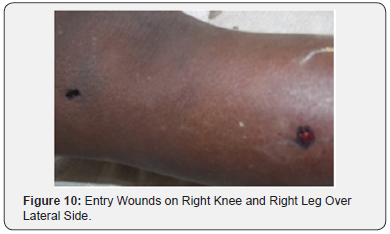
Body was sent for X-Ray examination and it was re-opened on 01/06/2018 at 1 PM for re-post-mortem examination for accurate assessment of number of pellets recovered and if by chance any of the pellets left in the body cavity undiscovered. The post-mortem radiograph demonstrated multiple pellets of different body regions. All pellets were recovered during re-postmortem examination done on 01/06/2018 after post-mortem radiograph done on 30/05/2018. All the six pellets were sealed and handed over to the constable concerned (Figure 11).
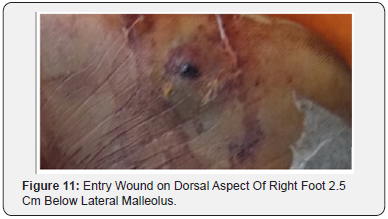
Ballistics Results
Determination of range
Range in Cylinder bore gun (Yards) = Dispersion of the pellets (in inches) x 1.5 As the dispersion of pellet in this case was 4.5 inches. Hence, Range = 4.5 x 0.9114 (meter) = 4.1013 meter Extreme range is:-R=2200 xDp

[Here R is in yards and Dp is pellet diameter] As this was buckshot of No. 4 Size. Hence diameter of pellet was 0.24 inches. Hence Extreme Range is R=2200 x 0.24= 528 yards = 481.21 meters (Figure 12).
Wounding power
A firearm projectile acquires its wounding power from kinetic energy, it possesses at the time it strikes the target. It is given by the formula: K.E. = ½ mv2 Muzzle velocity is taken at an effective range of shotgun which is 30-35 meters. The most important factor in determining the kinetic energy of the projectile is its velocity.
Striking velocity for a standard 12 bore cartridges is 199 m/s having size of shots 6, which is the case. K.E. =½ x6.5x10- 3x 199 x 199 = 128.7 joule the minimum effective velocity for killing a human being by 12 bore cartridges is 144m/s with 6 shot size, 6.5 gm weight. Hence K.E. will be- K.E. = ½ mv2=½ x6.5x10-3 =67.39 joule the recoil velocity permits the calculation of the desirable approximate weight of shotgun i.e. Backward momentum = Forward momentum = mV [Here v=muzzle velocity, m=weight of ejecta] = 199x6.5/1000 = 12.9Kg-m/s If the weight of gun ‘’W’’ is to be found when the velocity of recoil is 4.5m/s (the velocity which does not give gun sickness) We have Wx4.5 = 12.9 or W= 12.9/4.5 =2.87Kg Lighter guns are becoming popular. They give either greater recoil or the charge is reduced suitably to bring down the recoil (Figure 13).
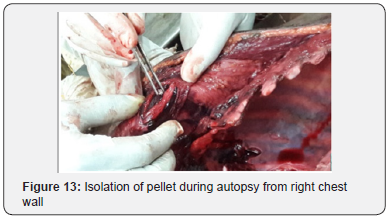
Ballistic coefficient (C)
It measures the ability of a projectile to retain the velocity is given by,
C= W/D2n
[n (form factor) it is 1 for cylindro-conoidal bullet and 2.3 for spheres]
Ballistic coefficient (C) for 6 shot sizes is 0.0096.
C= W/D2n = 6.5/6.1 x 10-3x1= 0.0065 [in this particular case]
Discussion
I. In our study, entry wound 3 mm on lower side of neck 3 cm away from midline, was present and metallic pellet of 2 gm weight was recovered from that site. In similar study done by M. Isa Kara et al, the result of multiple shotgun wounds especially in head and neck are fatal [8].
II. Liver is the most frequently damaged abdominal organ and is second only to the brain in overall visceral susceptibility (Figure 14).

III. If the force is directed straight at the liver along its anterior margin, lacerations occur both in the concave and convex surface. Trans capsular lacerations may cause rapid death from haemorrhage and shock. Penetrating wounds of the liver are relatively more common and may cause death by haemorrhage and shock [9].
IV. According to Abe et al, fatal case can be caused by only one shotgun pellet which penetrated the trunk of the victim [10]. (Figure 15)
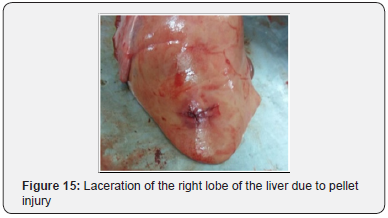
V. The wounding capability of a bullet depends on the amount of kinetic energy (KE) the bullet possesses when it strikes the target [11].
The amount of kinetic energy a moving projectile has is dependent upon its mass (weight, calibre) and velocity as expressed in the following formula:
KE= wv2/2g
In the formula:
KE= Kinetic Energy
w= the weight or mass of the bullet
v= the velocity of the bullet
g= gravitational acceleration
It should be stressed that the severity of a wound is directly related to the amount of kinetic energy given up within the body, and not the total energy possessed by the bullet [11].
Tissues with little elasticity, such as liver and brain, are more readily injured than those with elasticity, such as lung. Bullets that have a soft lead nose.
Comparison of muzzle velocity and kinetic energy of firearm cartridge, 22 short, standard velocity- Bullet weight= 29 grains
Muzzle velocity = 1045ft./s
Kinetic Energy = 70 foot-pounds
i. The energy required by a human target to be put out of action is given to be about 5.5 to 8 m-Kg. Therefore, the energy transfer required is about 50 times or more for human (target). Thus, if one small pellet can kill a bird, about 50 pellets are required to kill a man. It is in this context that the shotgun is termed only a short range firearm. Only at short range a number of pellets can hit a person [6].
ii. In India, as per the statistics of National Crime Records Bureau, in the year of 2014, total deaths due to firearm was 0.28 per 1,00,000 population, out of which 0.30 were homicides, 0.14 was suicides while 0.04 were unintentional, whereas `gun per 100 inhabitants in India was 4.2. (Figure 16)
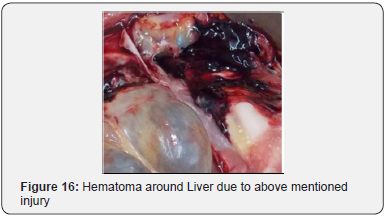
iii. In another study conducted by Klaulaskar S V et al. [4] during the period from 1 June ,2009 to 30 March 2011, in case of manner of death in fatal firearm injury, homicide accounted for maximum percentage (81.48%), followed by accident (9.25%, suicide (5.55%) [4].
iv. According to Burn Rice et al. [12] Buckshot can be lethal to humans past 100 yards.
In our study, the calculated backward momentum = forward momentum was 12.9Kg-m/s.
In a similar study by AK Gupta The recoil velocity permits the calculation of the desirable approximate weight of a shotgun
i.e. Backward momentum=Forward momentum
=VxM [Here V=muzzle velocity, M=weight of ejecta]
=400x35/1000
=14 units
If the weight of the gun is W is to be found when the velocity of recoil is 4.5m/s (the velocity which does not give ‘’gunsickness’’) we have Wx4.5=14
Or, W= 14/4.5= 3.1 Kg ~ 3Kg
A modern 12 bore cartridge develops a pressure of about 550 Kg per cm2. It is almost twice the pressure developed by a gunpowder (black powder) cartridge. The shotgun, therefore, meant for gunpowder cartridge cannot be used to fire cartridge containing smokeless propellants [6]. Smooth-bored firearms deliver excellent shot patterns and amazing slug-shooting accuracy up to 100 yards semi-automatic. Ordinarily shotguns are effective within the range of30 to 40 yards [13]. In our study muzzle velocity considered was for standard 12 bore cartridge where the size of shots was 6, was 199m/s and the minimum effective velocity to kill a person with having 6 shot sizes was 144 m/s. In another study by A. K. Gupta et al, most of the shotgun cartridge manufactured gives muzzle velocity close to the velocity of sound (400m/s). Consequently, the striking velocities are usually in sub-sonic zone [6]. A ricochet bullet is one which before striking the object aimed at, strikes some intervening object first, and then after ricocheting and rebounding (glancing) from these, hits the object (Figure 17). The critical angle of impact for ricochet of hard surfaces varies from 10 to 300 [14]. Ricocheting of a bullet may occur with inferior firearms and low velocity bullets. The bullet may be deformed and flattened before striking the skin. The degree of deformity varies depending on the texture of the bullet. This produces a large irregularly oval, triangular or cruciate entrance wound with irregular abraded margins. As they bullet loses gravitating movements, abrasion collar is absent. Burning, blackening and tattooing are also not seen.
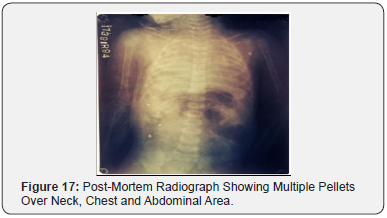
Types of ricochet
a. External ricochet-bullet rebounds on some external object (e.g. roof)
b. Internal ricochet- bullet rebounds off some internal body surface (e.g. inside of skull, chest)
External ricochet
a. Trajectory- completely unpredictable
b. Characteristics of ricochet bullet
Deformed and Flattened- Degree of deformity varies with the texture of the bullet (Figure 18). Soft lead bullets are deformed more than hard jacketed bullets. May contain chips of paint, soil, fibres or fragments from the intervening object. It lies in the wound nose facing outwards [2]. Accidental fire arm wounds are characterized by, their entrance could be on any area of the body, the shot distance is in close or very close range, it may be in any direction, number of wounds are usually one, gunpowder residues are present on the hands of the assailant, the weapon is found at the scene of crime, the scene of crime could be in his house or by hunting, the victims are mostly male and there is no motive behind this type of fire [14]. Similar incidences of celebratory/ happy firing took place recently on 22/02/2018 at New Delhi and on 01/05/2018 at Lakhimpur Khiri in U.P (Figure 19) where the groom was hit in chest by bullet, similar to findings of our study, and died [15,16].
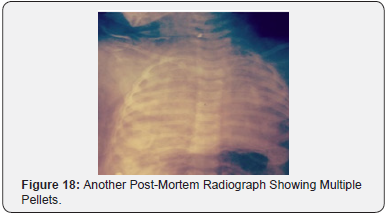

Conclusion
It was concluded that, Air fires while celebrating marriages, religious functions and social gatherings is illegal and may result in the initiation of legal action. Carrying a gun in a marriage procession is illegal under the Arms Act of 1959 and the Indian Penal Code of 1860 while the terms of licence also forbade carrying of gun to public assemblage. Over 85% of all murders committed using firearms have unlicensed guns involved. Not surprisingly, UP and Bihar make up 67% of all murders by unlicensed guns. In external ricocheting- an accused may claim that he merely fired at the roof to threaten his rival. But the bullet ricocheted off and hit him. If proved correct by Postmortem examination, he may be charged for Section 304A IPC (causing death by rash and negligent death), rather than for Section 302 (murder). The practice of celebratory firing by overenthusiastic and unskilled persons or defective, faulty or old and ill maintained firearms may cause accidental death of the persons during celebratory firing and may change the happiness of the ceremony into highly tragic event.
Acknowledgement
Authors would like to thank faculty and staff of department of Forensic Medicine IMS, BHU, Varanasi for their valuable support and full help in data collection from the autopsied case and providing with adequate literature support.
References
- Rajesh Bardale (2017) Firearm injuries and bomb blast injuries: Principles of Forensic Medicine & Toxicology, (2nd edn.), Jaypee Brother Medical Publishers Ltd, New Delhi, India pp.221.
- Anil Aggarwal (2014) Firearm Injuries: Textbook of Forensic Medicine and Toxicology, First ed. Chapter 13, Avital Publishing Company, New Delhi, India p. 255.
- Jason Payne-James, William Smock, Anthony Busuttil (2003) Forensic Medicine: Clinical and Pathological Aspects. J R Soc Med 69(10): 517- 518.
- Shashikant V Kaulaskar, Pandey SK, Yerpude Pravin N, Pathak Manoj, Jogdand Keerti S (2014) An Epidemiological Study of Fatal Firearm Cases in Varanasi, UP. Indian Journal of Forensic Medicine & Toxicology 8(2): 55-58.
- National Crime Records Bureau (2015) New Delhi. Statistics Victims of Murder (Age-group & Gender-wise).
- Gupta AK Paper No. 06: Forensic Ballistics, Module no. 25: Shotgun Ballistics, Anchor Institute-SGTB Khalsa College, University of Delhi.
- Gautam Biswas, Firearm Injuries (2015) Review of Forensic Medicine and Toxicology, (3rd edn.), Chapter 12, Jaypee Brother Medical Publishers Ltd, New Delhi, India pp. 222-223.
- Kara MI, Polat HB, Ay S (2008) Penetrated Shotgun Pellets: A Case Report, Eur J Dent 2(1): 59-62.
- Reddy KSN (2017) Regional Injuries: The Essentials of Forensic medicine & Toxicology, (34th edn.), 254-255.
- Abe M, Motani Saitoh H, Sato Y, Kiuchi M (2002) A fatal case of shotgun injury Caused by one pellet. Leg Med 4(2): 131-133.
- Jason Payne-James (2003) Gunshot Trauma: Forensic Medicine: Clinical and Pathological Aspects, 1st edition pp.155.
- Burn Rice, Degreed Gunsmith, Firearms SME, Firearms Instructor, Gun Law (2017) What is the range of a 12 bore single barrel gun if used with a No.4 cartridge?
- Modi, Injuries by Mechanical Violence: A Textbook of Medical Jurisprudence and Toxicology, 24thed, Chapter 24: 534-535.
- Reddy KSN (2017) Mechanical Injuries: The Essentials of Forensic medicine &Toxicology, (34thedn.), 9: 217.
- (2018) The New Indian Express, India.
- (2018) The Times of India.






























